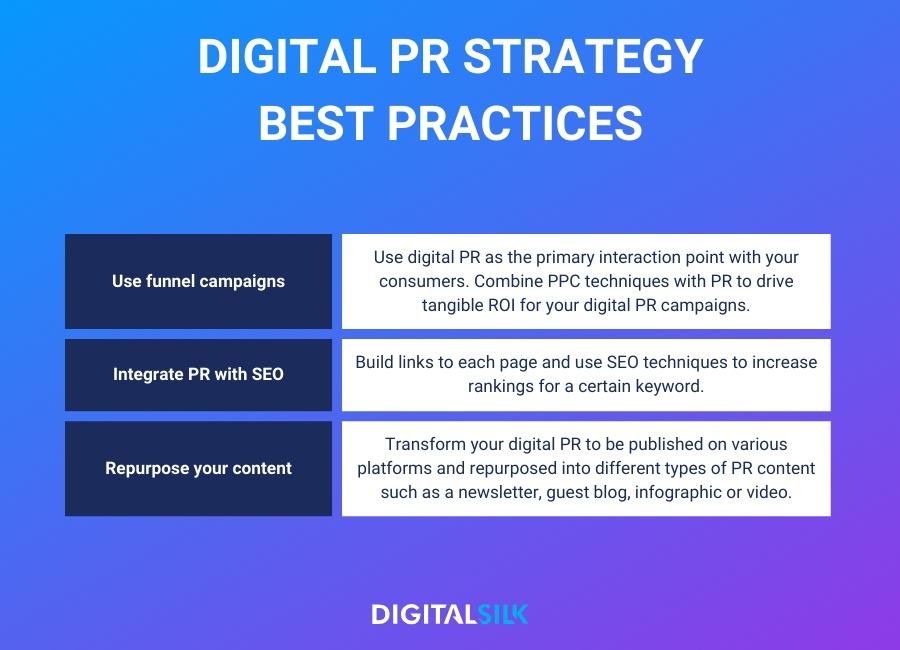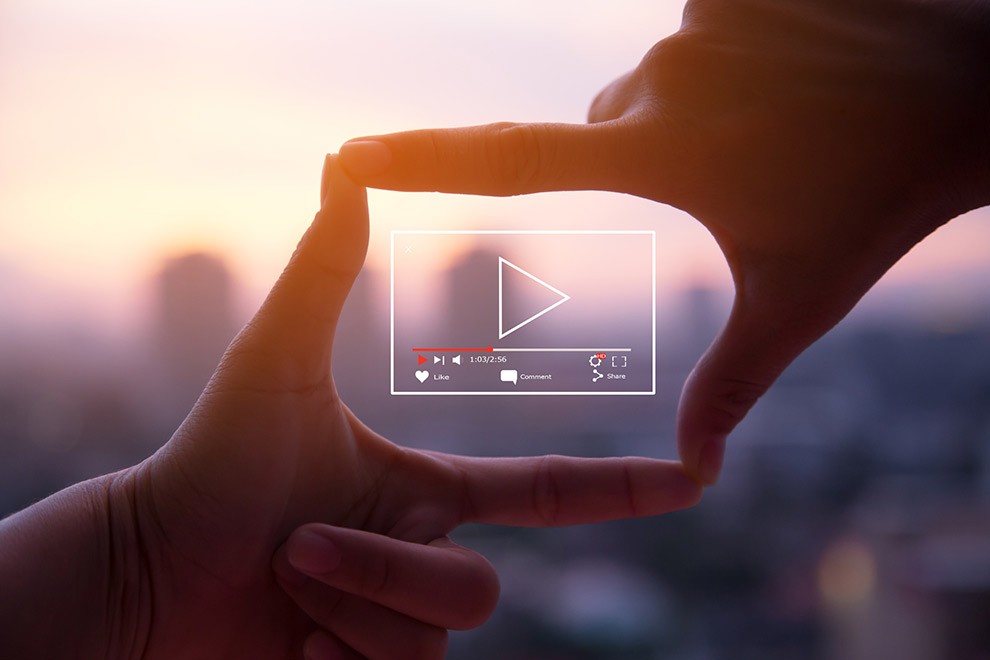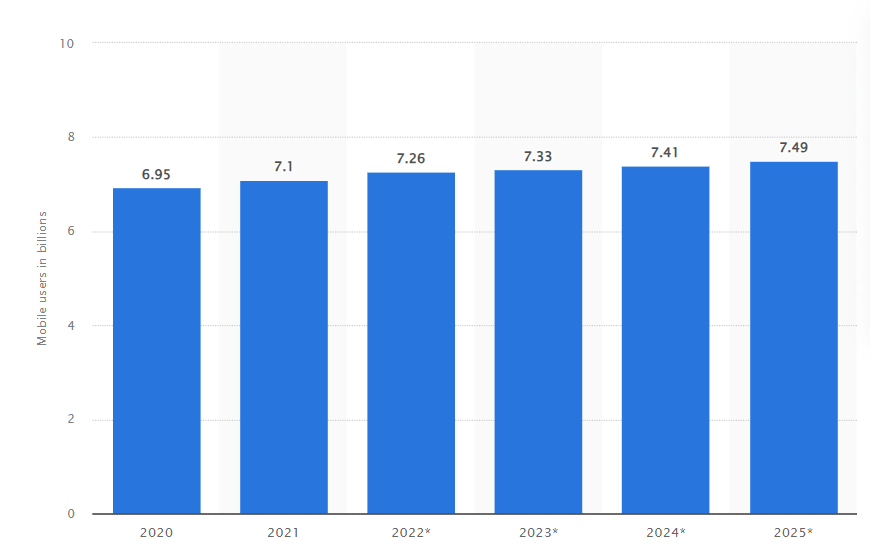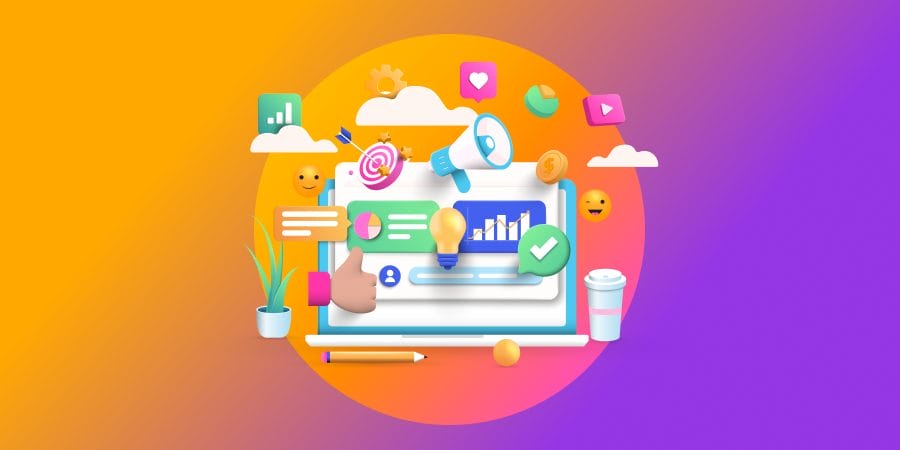97% of marketers think their business has at least some success with content marketing, with 61% citing the value it brings to their clients as the key benefit.
With strategic content marketing, you can connect with your audience, and in turn grow both your brand and your revenue.
In this article, we address the five most effective types of content marketing strategies, their best practices and where they stand in user journey.
We’ll also cover the advantages of content marketing as a part of your business growth strategy, the latest trends and the biggest challenges in content marketing for 2023.
[ez-toc]
Digital Silk creates results-driven strategies. Request a quote
What Is Content Marketing?
Content marketing is an inbound digital marketing strategy that relies on different types of content and channels to:
- Attract clearly defined audiences/leads into a business’ sales funnel
- Improve user journeys, influencing conversion
Depending on the format, purpose and delivery channel, content marketing can be broken into these subsets:
- Web content
- Blogs
- Email marketing
- Digital PR
- Video marketing
- eBooks
- Webinars
- Infographics
- Podcasts
- Checklists
- Social media marketing
- Quizzes
- Lead magnets
Let’s take a look at the advantages of having a well-defined content marketing strategy and what it can do for your business.
Meet our content strategy experts. Set Up A Consultation
Why Develop A Content Marketing Strategy?
A strategic content marketing strategy can play a key role in increasing brand visibility and generating valuable leads. Content marketing:
- Drives traffic to key landing pages:
- Boosts brand awareness:
- Creating brand awareness is the most common goal achieved by B2B marketers, with 86% claiming success over a one-year period.
- Increases lead generation and conversion:
- B2B companies who blog receive 67% more leads than those who don’t.
- Content marketing generates 3x as many leads as traditional marketing per dollar spent.
- Brings in revenue:
- Putting an emphasis on blogging makes a positive return on investment (ROI) 13x more likely, according to marketers.
Make your marketing funnel successful by using different types of content for different stages:
Top of the funnel, to generate brand awareness:
- Info web pages
- Blogs
- eBooks
- Vlogs
- Infographics
- Webinars
- Press releases
Middle of the funnel, to educate and nurture:
- Educational resources and downloadables
- Email campaigns / Newsletters
- Video presentations
- Event videos
Bottom of the funnel, to convert:
- Comparison sheets
- Case studies
- Testimonials
- Review pages
- Email campaigns / Abandoned cart recovery
Explore this case study and see how DigitalSilk optimized the website content of one of our clients and increased website sessions by 118%.
5 Best Content Marketing Examples That Work In 2023
Let’s take a look at the top five content marketing strategies, their position in the user journey and their best practices.
1. Web Content Strategy
Different kinds of web content can be used as a marketing strategy, but in this particular segment, we will focus on the one with the biggest potential – web copy.
Engaging web copy can help you build relationships, nurture leads and influence potential buyers. The goal is to answer the needs and desires of your audience, through your copy.
Focus on creating various types of content for the different stages of the sales funnel, taking into account the needs and expectations of users in each stage.
From awareness to consideration and conversion, use your web copy across the sales funnel to educate your audience about your services, share your message and influence prospects to make a final purchasing decision.
Web copy best practices include:
- Make your audience feel at home: To deliver a great copy, understand your audience and their reasons for browsing your brand’s website. Define their pain points and needs and deliver exactly the type of content they are looking for at each stage.
- Be brief: To create copy packed with value, use short sentences and small paragraphs. Focus on what’s really important to your audience. Don’t forget that most users only skim through your web pages.
- Highlight your unique value proposition: Motivate your readers to keep engaging with your business by showing them what makes your offers better than your competitors’.
- Present your unique brand personality: To ensure brand retention and memorability, use a consistent tone of voice to help your customers identify with your brand’s values and personality.
2. Blog Content Strategy
Blogging as a content marketing strategy has multiple benefits:
- It helps your website’s SEO
- It attracts leads through organic search results
- It nurtures leads by providing quality content
- It helps your readers make well-informed decisions about your brand and products
- It shapes brand reputation by positioning your business as an authority/thought leader
There are several types of blogs you can consider for your brand:
- Thought leadership & industry insights
- Newsroom
- Instructional (product use and other how-to’s)
- Inspirational
- Recruitment
Thought leadership content created by industry experts is, in particular, one of the most effective ways for generating leads.
B2B tech companies can use blogging content to generate interest and attract new leads into the sales pipeline.
Other types of content, such as case studies, demo videos, product descriptions, tutorials and client testimonials are also highly effective, especially when combined with blog articles.
So where does blogging belong in the marketing funnel?
Blogs belong at the top – or, at the beginning – of your conversion funnel, where your objective is to educate your potential customers who come into contact with your business for the first time.
At this stage, use blogging to raise your brand awareness and turn casual website visitors into loyal customers.
Blogging best practices include covering both evergreen techniques and rising trends based on the evolution of search engine algorithms and changes in audience behavior.
Blogging best practices include:
- Search Engine Optimization: Optimize your blogs for search engines to help them rank higher and improve your content’s visibility.
- Use relevant keywords
- Use images named according to keywords and content, along with captions and alt titles that are relevant to the topic
- Frontload the keywords in your headers
- Long-form content: Use in-depth insights to position your company as an industry expert. Address the following questions:
- What problems does my audience have?
- How can I help them solve their problems with my content?
- Is my content timely and will it remain relevant?
- “Skyscraping” technique: When writing a blog on a topic that was already covered, strive to make it better than the most popular and best-performing article online. Expand upon existing content and add more elements such as infographics, videos, images and more.
- Data-driven blogging: Use factual research and figures from experiments, surveys and testing to add value for your readers.
3. Email Marketing Strategy
By 2025, emails around the globe are expected to increase to 376.4 billion per day.
And, research has shown that effective email marketing can bring an average return of $36 for every $1 spent.
According to Mailchimp, emails have an average open rate of 21.33% and a 2.62% CTR.
However, the consumer behavior within your industry will impact this.
For example, Mailchimp found that while agriculture and food services see open rates of 23.31% and a 2.94% CTR, beauty and personal care receive a 16.65% open rate and 1.92% CTR.
Evidently, this shows the potential for higher levels of consumer connectivity through email marketing campaigns in the agriculture and food than in beauty and personal care.
Where does email marketing belong in the marketing funnel?
Email marketing is essential to any digital marketing funnel. That’s why 64% of small businesses use email marketing to reach their customers.
While you can use email marketing at all stages of the marketing funnel, it’s most effective in the middle and bottom of the funnel areas, in customer acquisition and retention.
Make sure you keep an up-to-date email list of both your new visitors and your existing customers.
Email marketing best practices include having an up-to-date email list of your visitors and existing customers, and using:
- Bold calls-to-action: Bring your recipients one step closer to the conversion point by leading them to your website or motivating them to complete a purchase or download an eBook.
- Engaging copy: Catchy subject lines are a no-brainer, but it’s also important to invest your time into the body copy of an email to make it to-the-point, concise and engaging.
- Segmenting: Divide your email lists into targeted groups according to common traits, needs and habits.
- Personalization: Send personalized messages to specific audience segments to better content with each potential lead, depending on where they’re at in the funnel.
4. Digital PR Strategy
Digital PR increases brand awareness by using online methods to reach a broader audience that traditional PR may not be able to reach.
It relies on search engine optimization, influencer outreach and social media to improve online presence and visibility.
Use these Digital PR tactics to improve your web presence:
- Create online press releases with relevant links that lead to your website
- Nurture relationships with online journalists and bloggers to generate online coverage
- Organize interviews
- Foster influencer marketing and outreach to increase mentions on social media and blogs
- Manage online reviews and comments
The benefits of effective digital PR include:
- Increased website traffic
- Becoming an authority in an industry
- Improving search engine optimization
- Boosting brand image
- Generating leads and sales
So, where does digital PR belong in the marketing funnel?
Digital PR is about raising awareness using traffic to the campaign or boosting the brand’s visibility by improving your ranking positions, which is why it belongs to the top of the marketing funnel.
Digital PR best practices include using its cross-funnel potential:
- Use funnel campaigns: Use digital PR as the primary interaction point with your consumers. Combine PPC techniques with PR, such as creating strategic ads to drive tangible ROI for your digital PR campaigns.
- Integrate PR with SEO: Build links to each page and use SEO techniques to increase rankings for a certain keyword.
- Repurpose your content: Transform your digital PR to be published on various platforms and repurposed into different types of PR content such as a newsletter, guest blog, infographic or video.
5. Video Marketing Strategy
Use video marketing to promote your brand, increase engagement on digital channels and educate prospects about your offering.
Video marketing is proven to be one of the most effective types of content.
For example, research shows that video landing pages can increase conversion rates by over 80%.
And, 93% of consumers say videos help them make buying decisions.
Video marketing can help compliment email marketing (according to Super Office, including ‘video’ in your email subject lines increases CTRs by 6%), encourage social shares and build trust and credibility with your brand.
Different types of videos in content marketing include:
- Demo videos
- How-to videos
- Expert interviews
- Case studies
- Customer testimonials
- VR videos
- Personalized messages
- Live videos
- Explainer videos
Where does video marketing belong in the marketing funnel?
Video marketing usually stands at the top of the conversion funnel due to its educational nature.
However, it can belong at any stage of the conversion funnel and user journey, depending on the content it contains. Video content can be adjusted to the specific needs of a prospect on different stages of their journey.
Video marketing best practices
- Establish a clear goal: To fully benefit from video marketing, ask yourself the following questions when defining your goals:
- What should the videos accomplish?
- How will I measure the results?
- Is the goal attainable?
- Does it align with my business objectives?
- Does the goal have a deadline?
- Optimize videos for SEO: Video content appears in video search results and regular search results. Google must be able to extract information to understand what the video is about so that your prospects can find it. You need to:
- Make the video crawlable
- Include meta tags and titles
- Use a video sitemap
- Use a call-to-action: Use CTA buttons as a part of your video and video landing page. Point your viewers to your website where they can download a whitepaper or get a discount offer — whatever your key conversion point might be. Use CTAs for your instructional videos, so your viewers can download the material they need. Consider call-to-action overlays that make clear offers to viewers.
5 Content Marketing Trends You Should Adopt In 2023
As digital marketers find new ways to engage their audience and deliver their messages, new trends are developing that enhance the content marketing game.
These five trends will dominate in 2023:
1. Voice Search Optimization
Voice search is on the rise, thanks to the mass adoption of smart speakers such as Siri and Alexa. This way of searching for answers is faster and easier than traditional queries.
Voice search is great for mobile, because 56% of all voice searches are made on a smartphone. It’s also locally-oriented, so it’s useful for local businesses.
In order to optimize your content for voice search, target question keywords such as “how,” “what,” “why,” “when,” and “where.”
Keep in mind that people typically use long-tail keywords to ask a question using voice search, so it’s important to implement long-tail phrases in both B2B and B2C content marketing.
2. Visual Storytelling Via Augmented Reality
To diversify the way your users perceive your products and services, use interactive features and create personalized experience. Here is a great example by Nike.
Take advantage of the following benefits of AR storytelling:
- It can be used in every industry
- It creates a uniquely engaging experience for your audiences and target groups
- It strengthens your interaction with your consumers
- It provides a practical approach to your company’s services and demonstrates how your users can benefit
- It does not require complicated instructions and equipment
Use AR to give your users the opportunity to “try before they buy,” anywhere, from anytime.
Tell the story of your business by showing your physical locations. Make your product guides easy to understand and use by providing virtual demonstrations and examples.
Check out this example of AR in the Nike commercial below:
3. Video Content
In 2022, people spent an average of 19 hours watching online videos each week.
Watching videos helps your potential customers learn more about your product or service.
Incorporate videos into your content marketing strategy can improve search engine rankings and conversions, since videos contribute to increased time on page.
4. Mobile Optimization
Mobile optimization is important across all content marketing channels and especially for email marketing, as the majority of emails are now opened on mobile devices. Websites that are mobile-friendly and responsive boost user experience and contribute to a higher rate of conversions.
By 2025, there will be 7.49 billion mobile users around the world.
Both the volume growth of the global mobile market and the priority mobile-friendly websites are getting from Google will make mobile optimization a continuous trend beyond 2023.
5. Personalization
As your customers get savvier and their expectations from brands continue to grow, you will need to find ways to communicate your value propositions on an individual level.
In a sea of competitors, personalized emails and strategically planned user journeys can help your users feel seen and heard.
Depending on what stage of the funnel your user is in, use email marketing to offer discounts, send abandoned cart reminders and welcome back visitors who you haven’t seen in a while.
The Biggest Content Marketing Challenges In 2023
While new developments in content marketing, SEO and digital technology can create new opportunities for marketers, they can also bring challenges.
Challenges you might encounter in 2023 include:
1. Zero-Click Searches
Zero-click searches occur when a user doesn’t have to click on a search result page to find their answer or desired information, because the answer appears directly on the search result page.
Users have their query answered instead by a featured snippet and do not click on any site featured on SERP.
According to SEMrush, more than a quarter of all desktop and over half of all mobile searches today are zero-click, owing to SERP, Featured Snippets and Local Packs.
Optimizing for rich and feature snippets is important because the zero-click searches are a big issue that impacts website traffic. Rich Snippets bring lower CTRs than Featured Snippets.
To help increase clicks, create well-researched quality content and optimize it for your target audience.
2. Matching The User Intent
In 2023, customer experience will be in the driving seat when it comes to optimizing content and digital channels. User intent is even reshaping the marketing funnel.
The customer journey is not linear anymore and most consumers don’t get to a purchase decision by following the straight line.
Your consumers may enter the funnel at any point and move forward or backward, from purchase to comparison.
But what is it that drives this reshaping of the marketing funnel?
The answer is simple: The marketing funnel is reshaped by the way consumers search for solutions, the way they compare products, and what motivate them to pull the trigger on a purchase.
Also, it’s how brands match their content to meet the points in which consumers are entering the funnel.
One of the content marketing challenges of 2023 will be shaping the funnel to match user intent.
3. Developing A Customer-Centric Mindset
Content marketing is not the same as advertising. It provides value to customers by giving them what they need at every stage of the user journey.
A customer-centric mindset means putting your customers first.
Focus on answering the questions your customers might have, and explaining the true value behind what you have to offer.
By keeping your unique value proposition (UVP) at the front and center, your customers will be able to see the benefits they’ll get from your products or services.
Takeaways On Content Marketing Strategies
The top content marketing strategies in 2023 cover every stage of your customer journey. It’s all about delivering the right kind of content at the right time.
From web copy and blogs to email marketing, digital PR and video marketing, create a detailed plan now to kickstart the new year for your brand.
Anticipate the content marketing challenges of 2023, such as zero-click searches and user intent, and implement:
- Voice search optimization
- Visual storytelling via AR
- Video content
- Mobile-friendly website
- Higher levels of personalization
At Digital Silk, we help brands build strong content marketing strategies to increase visibility drive traffic and rank high on search engines. From hotels and financial institutions to manufacturing and tech companies, each strategy is created with the unique individual brand in mind.
"*" indicates required fields





















